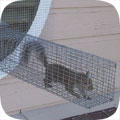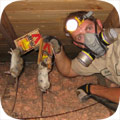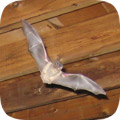- miami@wildlifeanimalcontrol.com
Call 24/7 for a free quote:
918-919-3463
Miami Wildlife Animal Control
Professional Wildlife Removal Company Servicing Miami, OK
If you have a problem with wildlife in your Miami home, your best option is to hire a company that specializes in Oklahoma wildlife removal only. This is a specialty business, and regular pest control companies do not use the proper techniques to solve animal problems. I have spent many years reviewing Oklahoma and Miami, and I recommend the following:
Wildlife Removal NE Oklahoma
Cell Phone: 918-919-3463
NOTE: If you have a dog or cat problem, call Ottawa County Animal Services: (918) 542-2129

Wildlife Removal NE Oklahoma specializes primarily in removing animals from attics of homes and buildings - this includes squirrels in attics, raccoons, and rats or mice in homes. Oklahoma also has a documented problem with
bats in buildings, and Wildlife Removal NE Oklahoma is specially trained in bat removal. They also perform general wildlife trapping services, such as the capture and removal of skunks or opossums on the
property. Call 918-919-3463 to discuss your critter problem and schedule a same-day or next-day appointment. Click here to learn more about what prices we charge in 2020.
When hiring a company to solve your wild animal problem, you want these features:
- Specializes in wildlife removal, not pest control
- Fully Oklahoma and Ottawa County licensed and insured
- Works 7 days per week (critters don't take weekends off)
- Performs full building inspections: enters and inspects attic
- Performs exclusion repairs, with guarantee against animal re-entry
- Offers cleanup of biohazardous wildlife waste
Wildlife Removal NE Oklahoma is a full-service Miami wildlife removal company. This is very different from a regular Miami pest control company. The pest control companies spray poison to kill insects. This is not at all
similar to wildlife removal. Wildlife Removal NE Oklahoma performs a full inspection of the home or property, and determines why the animal(s) are there, and if inside a building, how the animals got inside. All
animals (including rodents) are trapped and removed, or if possible, removed from the building using special exclusion devices. Once the animals are gone, preventative repairs are essential, and
cleanup is sometimes recommended.
 Miami wildlife trapping - it's not as simple as it may seem. It's illegal in Oklahoma to trap without a license. Trap type is very important and there are many different types, bait is somewhat relevant, trap placement
is vital, and there are dozens of small things that are very important to know.
Safety is a concern. Then once the animal is trapped, it must be removed and dealt with in the proper manner according to Oklahoma law. We offer Miami raccoon removal. Read more about how to get rid of raccoons.
Miami wildlife trapping - it's not as simple as it may seem. It's illegal in Oklahoma to trap without a license. Trap type is very important and there are many different types, bait is somewhat relevant, trap placement
is vital, and there are dozens of small things that are very important to know.
Safety is a concern. Then once the animal is trapped, it must be removed and dealt with in the proper manner according to Oklahoma law. We offer Miami raccoon removal. Read more about how to get rid of raccoons.
 Animals in attics - this is our specialty at Wildlife Removal NE Oklahoma. Many types of animals like to live in attics. This includes squirrels, raccoons, rats, mice, bats, birds, and even possums. Critters like to go into attics for a safe place to live
and raise their young. Removing animals from attics is very complex work, partly because of the presence of baby animals. If you need Miami squirrel removal, we can remove all the squirrels from your attic, and seal out any future ones. Read more about how to get rid of squirrels.
Animals in attics - this is our specialty at Wildlife Removal NE Oklahoma. Many types of animals like to live in attics. This includes squirrels, raccoons, rats, mice, bats, birds, and even possums. Critters like to go into attics for a safe place to live
and raise their young. Removing animals from attics is very complex work, partly because of the presence of baby animals. If you need Miami squirrel removal, we can remove all the squirrels from your attic, and seal out any future ones. Read more about how to get rid of squirrels.
 Rodent control must be done in a very specific way. First off, the most important thing is that all the openings that rats and mice can use to enter a house be sealed. Then all the rodents must be physically trapped and removed.
Never, ever use poison! Most Miami exterminators will just use this lazy poison technique to kill rodents, and it causes more harm than good - dead stinky rats, and it doesn't solve the problem. Call us for correct Miami rat removal. Read more about how to get rid of rats.
Rodent control must be done in a very specific way. First off, the most important thing is that all the openings that rats and mice can use to enter a house be sealed. Then all the rodents must be physically trapped and removed.
Never, ever use poison! Most Miami exterminators will just use this lazy poison technique to kill rodents, and it causes more harm than good - dead stinky rats, and it doesn't solve the problem. Call us for correct Miami rat removal. Read more about how to get rid of rats.
 Bat removal is a highly specialized task. Oklahoma is known to have colonizing bats who often live in buildings. Bats love attics. If not removed, the colony can grow to a very large size over the years. The bat droppings are often corrosive and
cause health risks. The same goes for bird droppings on or in buildings. We perform Miami pigeon removal and bird control. But our specialty is Miami bat removal. We remove 100% of the bat colony and seal the building so that it's totally bat-proof. Read more about how to get rid of bats.
Bat removal is a highly specialized task. Oklahoma is known to have colonizing bats who often live in buildings. Bats love attics. If not removed, the colony can grow to a very large size over the years. The bat droppings are often corrosive and
cause health risks. The same goes for bird droppings on or in buildings. We perform Miami pigeon removal and bird control. But our specialty is Miami bat removal. We remove 100% of the bat colony and seal the building so that it's totally bat-proof. Read more about how to get rid of bats.
 If you have animals inside a house, no job is complete without proper exclusion repairs. If you simply hire a Miami trapper who only removes the critters, then the problem will return. You need to hire a Miami wildlife control company that identifies 100% of the animal entry points
into your building, and seals them shut with professional repairs. In addition, in many cases animals have left waste or contamination behind, and you'll want a company that can provide professional cleaning services. Wildlife Removal NE Oklahoma does both.
If you have animals inside a house, no job is complete without proper exclusion repairs. If you simply hire a Miami trapper who only removes the critters, then the problem will return. You need to hire a Miami wildlife control company that identifies 100% of the animal entry points
into your building, and seals them shut with professional repairs. In addition, in many cases animals have left waste or contamination behind, and you'll want a company that can provide professional cleaning services. Wildlife Removal NE Oklahoma does both.
The above are just some of the services offered by Wildlife Removal NE Oklahoma. We also trap and remove animals that destroy lawns, such as moles, or digging animals. Sometimes animals like opossums will live under buildings, steal pet food, raid garbage cans, etc.
Read about how to get rid of opossums. Skunks commonly live under sheds or decks, and set up a den. We can trap and remove them without them spraying. Read about how to get rid of skunks. Wildlife Removal NE Oklahoma
also provides dead animal removal in Miami. If you need help with any other wildlife conflict, from a fox, beaver, groundhog, or any other critter, we can solve it. We also do Miami snake removal - most of the snakes in Oklahoma are not venomous, but
call us if you want safe removal, or read about how to get rid of snakes in Miami. And remember, we are a private business, not Ottawa County Animal Control Services, so if you have a dog or cat problem, call the County at (918) 542-2129.
Ottawa County animal services does not handle any wildlife issues.
Wildlife Removal NE Oklahoma: 918-919-3463
Miami Pricing Info For Year 2020
 Every wildlife removal situation is different, from the species of animals involved, the location of the animal inside a house or outside, the extent of repairs or cleanup, etc. It's impossible to give one-size-fits-all prices. Examples MIGHT include:
Every wildlife removal situation is different, from the species of animals involved, the location of the animal inside a house or outside, the extent of repairs or cleanup, etc. It's impossible to give one-size-fits-all prices. Examples MIGHT include:
Small Job: For example, a one-stop job to remove an animal in the yard: $100 on up
Medium Job: For example, getting critters out of your house with minor repairs: $300 on up
Large Job: For example, a project involving many service trips and complex work: $500 on up
Give us a phone call now and tell us about your wildlife issue and we will be able to give you a price estimate over the phone. If you're cool with it, we can schedule a same-day or next-day appointment if you like. Our prices are fair, and a good value because we do the job right, the first time.
Miami Wildlife Tip #1:
What Is Histoplasmosis?
Histoplasmosis is basically a disease that is caused by infection with fungus. This infection is usually caused by inhaling the spores of the fungus which are airborne. Usually many people who have been exposed to the fungus do not develop histoplasmosis but some of them do. Those who have a reduced immune function are more prone to this disease.
Histoplasmosis is usually caused by a fungus named Histoplasma Capsulatum, which is found in the surrounding whenever there is a bat or a bird dropping. If you have got this infection, then there is a chance that you would get a lung disease which is very similar to pneumonia. In other cases, the infection also spreads throughout the body. This is the case of disseminated disease. People with weak immune system like those with HIV/AIDS can be severe cases of this disease. Other than these, people taking chemotherapy, or people taking immune suppressant medications are also prone to histoplasmosis.
What causes histoplasmosis?
The organism causing histoplasmosis is a fungus Histoplasma Capsulatum. Whenever you see a bat in the house, there may be a case that you can develop histoplasmosis. Usually bat droppings contain this fungus and whenever they excrete, that area can be source of the airborne fungus.
Risk Factors
It is possible that anyone can develop histoplasmosis. But they are more profound in the case of young children, infants and elder people. Also it is mentioned above that people with weak immune system are more prone to that disease. Also people working in the demolition field are also prone to this disease.
Symptoms and Signs
As it is mentioned before, not everyone who inhales the fungus gets sick. But if you are about to get sick, the signs and the symptoms would usually take 3 to 17 days to occur after you have been exposed. Most of the symptoms are similar to pneumonia like fever, chills, dry cough, chest pains and malaise. Some of the people can also experience joint pain.
Also after the detection of the disease, if still it is not taken care of, then those who have been affected can also develop shortness of breath, weight loss and fatigue. If the infection has spread to the central nervous system, severe symptoms can also be developed such as headaches, seizures, etc. Person affected may also start becoming confused most of the time.
It is difficult to get a diagnosis of this disease just by looking at the symptoms. Some tests are required to get a proper diagnosis, such as taking cultures of body fluids to identify the type of fungus, via urine test, and blood tests. Histoplasmosis can become a severe disease if not taken care of in time.
Miami Wildlife Tip #2:
Oklahoma Wildlife Information:
Oklahoma State bird: Scissor-tailed flycatcher
State mammal: Bison
State reptile: Common collared lizard
State amphibian: North American bullfrog
State fish: White bass
State insect: European honeybee
Oklahoma is a land filled with lush grasslands, absent of tall mountains. The state does have numerous mountain ranges, but most of these are mesa-like, surrounding canyons and winding rivers. Of all the states in the country, Oklahoma is one of the most diverse when it comes to habitats. Though only 24 percent of the region is forested, there are areas of wetlands, grasslands, woodlands, and semi-arid zones. The state sits in the midst of the Great Plains, and it is subject to severe weather throughout the year. The weather is mostly warm and wet, though temperature differences can be significant between the north and south parts of the state.
Being in the central Great Plains, it's not surprising to learn that bison still roam this region. Rampant slaughter of the large grazing animals during the early years of the country almost wiped the species out. Now, as a protected animal, bison once again roam the grasslands along with herds of elk and white-tailed deer. There are not many large predators in the state. Black bears are the largest, but they rarely go after something as large as a deer, being content to forage for berries and insects. Coyotes are the primary predator and are scattered around the region. Wolves were once native to the state, but the last wolf in Oklahoma was seen back in the 1930's.
A state with abundant grassland will be a state with an abundance of small animals. The wide spaces are ideal for prairie dogs, and these little creatures can prove very detrimental to farmers and their equipment. Other nuisance animals are bats, skunks, rats, mice, squirrels, and armadillos.
The state has a fair portion of wetlands in the south where semi-aquatic animals spend their time. The entirety of Oklahoma is fed by some 500 rivers and streams. It is the state with the most man-made reservoirs. In the wetlands, cypress trees conceal the American alligator, turtles, snakes, birds, and lizards. A common nuisance animal, the raccoon, is particularly fond of the swamp lands, sneaking in to steal eggs from birds and lizards alike. State conservationists looking to monitor the wetlands pay close attention to the raccoon population. If the raccoons vanish, something is wrong in the ecosystem.
You can always call Wildlife Removal NE Oklahoma, any time of day, at 918-919-3463, for a price quote for Miami wildlife control services. I am confident that this is the best choice amongst wildlife removal companies in Miami, OK.





































